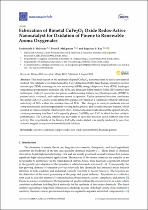 ResearchSpace
ResearchSpace
Fabrication of bimetal CuFe2O4 oxide redox-active nanocatalyst for oxidation of pinene to renewable aroma oxygenates
JavaScript is disabled for your browser. Some features of this site may not work without it.
- ResearchSpace
- →
- Research Publications/Outputs
- →
- Journal Articles
- →
- View Item
| dc.contributor.author |
Mdletshe, Lindokuhle S

|
|
| dc.contributor.author |
Makgwane, Peter R

|
|
| dc.contributor.author |
Ray, Suprakas S

|
|
| dc.date.accessioned | 2019-10-04T07:14:09Z | |
| dc.date.available | 2019-10-04T07:14:09Z | |
| dc.date.issued | 2019-08 | |
| dc.identifier.citation | Mdletshe, L.S., Makgwane, P.R. and Ray, S.S. 2019. Fabrication of bimetal CuFe2O4 oxide redox-active nanocatalyst for oxidation of pinene to renewable aroma oxygenates. Nanomaterials, v9(8), 17pp | en_US |
| dc.identifier.issn | 2079-4991 | |
| dc.identifier.uri | https://www.ncbi.nlm.nih.gov/pubmed/31395824 | |
| dc.identifier.uri | https://doi.org/10.3390/nano9081140 | |
| dc.identifier.uri | http://hdl.handle.net/10204/11150 | |
| dc.description | © 2019 by the authors. This article is an open access article distributed under the terms and conditions of the Creative Commons Attribution (CC BY) license. | en_US |
| dc.description.abstract | This study report on the synthesis of spinel CuFe2O4 nanostructures by surfactant-assisted method. The catalysts were characterized by X-ray diffraction (XRD), laser Raman, transition electron microscope (TEM), scanning electron microscope (SEM), energy dispersive X-ray (EDX), hydrogen temperature programmed reduction (H2-TPR), and Brunauer-Teller-Emmett-Teller (BET) surface area techniques. CuFe2O4 was active for pinene oxidation using tertiary butyl hydroperoxide (TBHP) to pinene oxide, verbenol, and verbenone aroma oxygenates. Under optimized reaction conditions, the spinel CuFe2O4 catalyst could afford 80% pinene conversion at a combined verbenol/verbenone selectivity of 76% within the reaction time of 20 h. The changes in catalyst synthesis solvent composition ratios induced significantly varying redox, phases, and textural structure features, which resulted in various catalytic enhancement effect. Characterization results showed the spinel CuFe2O4 catalyst possessing less than 5 wt% impurity phases, Cu(OH)2, and CuO to afford the best catalytic performance. The CuFe2O4 catalyst was recyclable to up to five reaction cycles without loss of its activity. The recyclability of the bimetal CuFe2O4 oxide catalyst was simply rendered by use of an external magnet to separate it from the liquid solution. | en_US |
| dc.language.iso | en | en_US |
| dc.publisher | Elsevier | en_US |
| dc.relation.ispartofseries | Worklist;22679 | |
| dc.subject | Biomass | en_US |
| dc.subject | Copper oxide | en_US |
| dc.subject | Iron oxide | en_US |
| dc.subject | Nanoparticles | en_US |
| dc.subject | Pinene | en_US |
| dc.subject | Selective oxidation | en_US |
| dc.title | Fabrication of bimetal CuFe2O4 oxide redox-active nanocatalyst for oxidation of pinene to renewable aroma oxygenates | en_US |
| dc.type | Article | en_US |
| dc.identifier.apacitation | Mdletshe, L. S., Makgwane, P. R., & Ray, S. S. (2019). Fabrication of bimetal CuFe2O4 oxide redox-active nanocatalyst for oxidation of pinene to renewable aroma oxygenates. http://hdl.handle.net/10204/11150 | en_ZA |
| dc.identifier.chicagocitation | Mdletshe, Lindokuhle S, Peter R Makgwane, and Suprakas S Ray "Fabrication of bimetal CuFe2O4 oxide redox-active nanocatalyst for oxidation of pinene to renewable aroma oxygenates." (2019) http://hdl.handle.net/10204/11150 | en_ZA |
| dc.identifier.vancouvercitation | Mdletshe LS, Makgwane PR, Ray SS. Fabrication of bimetal CuFe2O4 oxide redox-active nanocatalyst for oxidation of pinene to renewable aroma oxygenates. 2019; http://hdl.handle.net/10204/11150. | en_ZA |
| dc.identifier.ris | TY - Article AU - Mdletshe, Lindokuhle S AU - Makgwane, Peter R AU - Ray, Suprakas S AB - This study report on the synthesis of spinel CuFe2O4 nanostructures by surfactant-assisted method. The catalysts were characterized by X-ray diffraction (XRD), laser Raman, transition electron microscope (TEM), scanning electron microscope (SEM), energy dispersive X-ray (EDX), hydrogen temperature programmed reduction (H2-TPR), and Brunauer-Teller-Emmett-Teller (BET) surface area techniques. CuFe2O4 was active for pinene oxidation using tertiary butyl hydroperoxide (TBHP) to pinene oxide, verbenol, and verbenone aroma oxygenates. Under optimized reaction conditions, the spinel CuFe2O4 catalyst could afford 80% pinene conversion at a combined verbenol/verbenone selectivity of 76% within the reaction time of 20 h. The changes in catalyst synthesis solvent composition ratios induced significantly varying redox, phases, and textural structure features, which resulted in various catalytic enhancement effect. Characterization results showed the spinel CuFe2O4 catalyst possessing less than 5 wt% impurity phases, Cu(OH)2, and CuO to afford the best catalytic performance. The CuFe2O4 catalyst was recyclable to up to five reaction cycles without loss of its activity. The recyclability of the bimetal CuFe2O4 oxide catalyst was simply rendered by use of an external magnet to separate it from the liquid solution. DA - 2019-08 DB - ResearchSpace DP - CSIR KW - Biomass KW - Copper oxide KW - Iron oxide KW - Nanoparticles KW - Pinene KW - Selective oxidation LK - https://researchspace.csir.co.za PY - 2019 SM - 2079-4991 T1 - Fabrication of bimetal CuFe2O4 oxide redox-active nanocatalyst for oxidation of pinene to renewable aroma oxygenates TI - Fabrication of bimetal CuFe2O4 oxide redox-active nanocatalyst for oxidation of pinene to renewable aroma oxygenates UR - http://hdl.handle.net/10204/11150 ER - | en_ZA |





